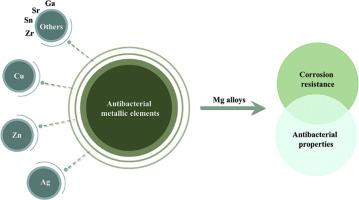当前位置:
X-MOL 学术
›
Mater. Des.
›
论文详情
Our official English website, www.x-mol.net, welcomes your
feedback! (Note: you will need to create a separate account there.)
Role of antibacterial metallic elements in simultaneously improving the corrosion resistance and antibacterial activity of magnesium alloys
Materials & Design ( IF 7.6 ) Pub Date : 2021-01-01 , DOI: 10.1016/j.matdes.2020.109350 Zhensheng Lin , Xiaoting Sun , Huazhe Yang
Materials & Design ( IF 7.6 ) Pub Date : 2021-01-01 , DOI: 10.1016/j.matdes.2020.109350 Zhensheng Lin , Xiaoting Sun , Huazhe Yang

|
Abstract Magnesium-based biodegradable alloys exhibit excellent mechanical properties and bioactivity, which are favorable in the orthopedic applications. In addition, the degradation of Mg alloys results in an alkaline microenvironment which can effectively withstand bacteria. However, the degradation rate of Mg is too fast to sustain the healing process. And enhancement of its corrosion resistance may compromise the antibacterial ability, thus, alloying with antibacterial elements or doping these elements into coatings on Mg and its alloys may be a prospective strategy to combine the corrosion resistance and antibacterial activity together. This review mainly discussed the role of common antibacterial metallic elements in improving the antibacterial properties and corrosion resistance of Mg-based alloys, including sliver (Ag), Zinc (Zn) and Copper (Cu). Besides, the potential antibacterial mechanism of Mg has been proposed systematically.
中文翻译:

抗菌金属元素在同时提高镁合金耐蚀性和抗菌活性中的作用
摘要 镁基可生物降解合金具有优异的力学性能和生物活性,在骨科应用中具有良好的应用前景。此外,镁合金的降解导致可以有效抵抗细菌的碱性微环境。然而,镁的降解速度太快而无法维持愈合过程。并且其耐腐蚀性的增强可能会损害抗菌能力,因此,与抗菌元素合金化或将这些元素掺杂到镁及其合金的涂层中可能是将耐腐蚀性和抗菌活性结合在一起的前瞻性策略。本综述主要讨论了常见的抗菌金属元素在提高镁基合金抗菌性能和耐腐蚀性方面的作用,包括银(Ag)、锌 (Zn) 和铜 (Cu)。此外,还系统地提出了Mg的潜在抗菌机制。
更新日期:2021-01-01
中文翻译:

抗菌金属元素在同时提高镁合金耐蚀性和抗菌活性中的作用
摘要 镁基可生物降解合金具有优异的力学性能和生物活性,在骨科应用中具有良好的应用前景。此外,镁合金的降解导致可以有效抵抗细菌的碱性微环境。然而,镁的降解速度太快而无法维持愈合过程。并且其耐腐蚀性的增强可能会损害抗菌能力,因此,与抗菌元素合金化或将这些元素掺杂到镁及其合金的涂层中可能是将耐腐蚀性和抗菌活性结合在一起的前瞻性策略。本综述主要讨论了常见的抗菌金属元素在提高镁基合金抗菌性能和耐腐蚀性方面的作用,包括银(Ag)、锌 (Zn) 和铜 (Cu)。此外,还系统地提出了Mg的潜在抗菌机制。











































 京公网安备 11010802027423号
京公网安备 11010802027423号